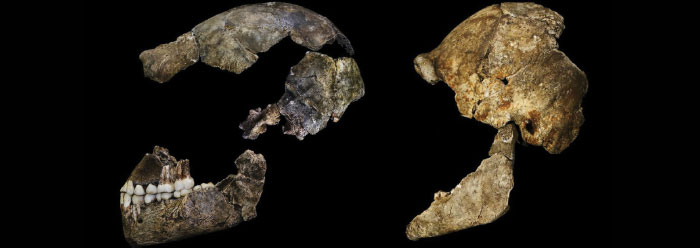Recent claims of a transitional species named Homo naledi have the anthropological world in an uproar.1-3 The new fossil “species” is said to be a humanlike ancestor that neatly fills the gap between Australopithecus and our own genus, Homo.1,3 This seems to fit the human evolution story, but is the claimed hominin actually a newly discovered transitional species between man and ape?
The fossil discovery, made in the Rising Star cave system in South Africa in 2013, is located in a remote section called Dinaledi Chamber. The scientists had to travel through two thin passageways, one less than eight inches wide in places.3 These caves developed in dolomite (a limestone-like rock) in sediments of the Malmani Subgroup. Secular scientists date the cave system as developing during the Pliocene-Pleistocene—assigning ages as high as three million years.2 However, creation scientists interpret caves like these as forming either during the receding-water phase of the Flood or right afterward, making the caves only thousands of years old.
Researchers recovered 1,550 scattered hominin bone pieces—alleged to represent at least 15 individuals that include infants, juveniles, and adults—from the clay-rich sediment of the cave floor. The secular scientists claimed these fragments are from a single, new species they named Homo naledi.1 Interestingly, the cave had been entered by a previous caving group that rearranged some of the bones.2
What exactly is Homo naledi? Lee Berger, the lead researcher, claims the bones all fit one new transitional, or mosaic, species.1 A transitional species should show partly evolved, in-between features of the two species it supposedly bridges. No fossil evidence for an undisputed transitional species exists anywhere for any kind of creature. A supposed mosaic species has features resembling unrelated kinds that are all somehow integrated. Homo naledi’s feet and hands fall in the range of modern humans,4,5 yet the pelvis and shoulders were more like Australopithecus—an extinct ape.6 Steve Churchill from Duke University told National Geographic, “If you’d found the foot by itself, you’d think some Bushman had died.”3
Also, the cranium pieces didn’t seem to fit the jaws. Despite what artistic depictions show, no substantially complete skulls were found with jaw and cranium attached. Instead, researchers found “tiny little brains stuck on these bodies that weren’t tiny,” as paleoanthropologist Fred Grine noted.3 All of these unusual sizes and mixtures of human and apelike traits indicate the bones may not even match. Presumed males and females may have come from different species. Could these paleontologists have fabricated a new species by cobbling together parts from unrelated kinds? Did they use the imaginings of their expectations—extrapolation— to put the pieces together? If so, it wouldn’t be the first time.7
However, what made this discovery unusual was the relatively loose and uncemented sediment in which the bones were found—all in the upper 20 cm (8 inches) of cave-filling floor sediment.2 One recent geological report said, “Hominin remains in the area are generally encased in lithified clastic deposits [weathered debris cemented together].”2 In other words, hardened sedimentary rocks encase most of these types of fossils, including Berger’s 2008 discovery of Australopithecus sediba only 10 miles away. That apelike fossil was dated by secular scientists as two million years old.8 Finding these “naledi” fossils in uncemented, loose sediment implies these fossils may be far more recently deposited than most other nearby finds, opening up the possibility they date to the post-Flood Ice Age, which would make Homo naledi only about 4,000 years old!
References
- Berger, L. R. et al. Homo naledi, a new species of the genus Homo from the Dinaledi Chamber, South Africa. eLife. Posted on elifesciences.org September 10, 2015, accessed October 1, 2015.
- Dirks, P. H. G. M. et al. Geological and taphonomic context for the hominin species Homo naledi from the Dinaledi Chamber, South Africa. eLife. Posted on elifesciences.org September 10, 2015, accessed October 1, 2015.
- Shreeve, J. This Face Changes the Human Story. But How? National Geographic News. Posted on news.nationalgeographic.com September 10, 2015, accessed October 15, 2015.
- Harcourt-Smith, W. E. H. et al. The foot of Homo naledi. Nature Communications. Posted on nature.com October 6, 2015, accessed October 8, 2015.
- Kivell, T. L. et al. The hand of Homo naledi. Nature Communications. Posted on nature.com October 6, 2015, accessed October 8, 2015.
- Lubenow, M. 1992. Bones of Contention. Grand Rapids, MI: Baker Books.
- Gish, D. 1975. Man...Apes...Australopithecines...Each Uniquely Different. Acts & Facts. 4 (9).
- Although secular science interprets these bones as two million years old, they were likely deposited late in the Flood year, making them about 4,500 years old.
Image credit: Copyright (c) 2015 National Geographic Society. Sources: L. Berger and P. Schmid, University of the Witwatersrand, South Africa; J. Hawks, University of Wisconsin-Madison. Adapted for use in accordance with federal copyright (fair use doctrine) law. Usage by ICR does not imply endorsement of copyright holder.
* Dr. Clarey is Research Associate at the Institute for Creation Research and received his Ph.D. in geology from Western Michigan University.














